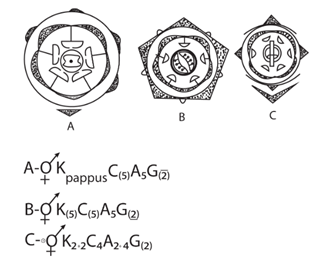 Multiple Choice Questions
Multiple Choice QuestionsStudy the following statements and select the option with correct statements.
I and II
I and III
II and III
I, II and III
The material, which arrests cell division, is obtained from
Crocus
Colchicum
Dalbergis
Chysanthomum
Three floral diagrams are given here. Their respective families are assigned in the answer key. Find out the families to which these diagrams belong to

A-Liliaceae, B-Asteraceae, C-Solanaceae
A-Asteraceae, B-Solanaceae, C-BRassicaceae
A-Asteraceae, B-Solanaceae, C-Asteraceae
A-Poaceae, B-Solanaceae, C-Asteraceae
A fern prothallus is bisexual. If fertilisation takes place between their gametes than it is known as
cross- fertilisation
self- fertilisation
isogamous
viviparous
